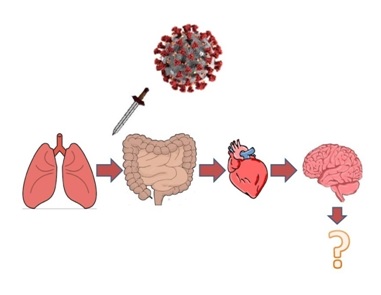Despite of severe measures and understanding, the pandemic response of COVID-19 remains hamstrung. COVID-19 unlike its sisterly outbreak in the past isn’t sticking to the roots of being a strict respiratory virus. It is invading via diverse pathways affecting multiple organs and hence causing significant morbidity and mortality. A deep understanding of the underlying pathways, classification of the disease and multiple-faceted therapeutics is utmost necessary to drive towards a terminal point.
The deadly malady Corona virus disease 2019 (COVID-19) out broke in Wuhan, China. COVID-19 is characterised by symptoms like fever, dry cough, fatigue and sore throat. COVID-19 gained its popularity with the significant morbidity and mortality risk it is posing. Apart from being humanity killer, pandemics like COVID-19 also hit global economy for example an enormous loss to global tourism estimated to be around US$22 billion.
Talking of the disease, clinical manifestations were the most important aspects considered in treating patients. Symptoms varied from index of less common index like dizziness, nausea and vomiting to severe illness index like pharyngeal pain, anorexia, etc. Additionally, co-morbidities were considered being of high risk like cardiovascular disease, cerebrovascular disease, ageing etc. Older patients admitted have often died because of their original co morbidities like kidney disease, malignant cancers etc. which resulted in more clinical attention. More recognition towards multi organ malfunction was gained when patients’ condition deteriorated from original comorbidities after admission.
The primary target organ is lungs and the most common clinical symptom is acute respiratory distress syndrome, but the unexpected and novel effect was observed in other vital organs like liver, gastrointestinal tract, brain and heart. Liver impairment was noticed in patients. In a recent study in a hospital in China, nearly half of the patients admitted with COVId-19 infection i.e. up to 53 per cent cases were out withabnormal levels of alanine aminotransferase and aspartate minotransferase. Surprisingly, liver injury was more pervasive in severe COVID-19 than mild. This evidence hinted towards the possibility of the virus binding to angiotensin-converting enzyme 2 (ACE2) where the real magic transpires as in the virus replicates and enters other cells. What really makes the scenario worst for the clinicians is again the co- orbidities. A patient with pre existing cirrhosis or cancer would be more possibly be susceptible to the infection because of their state of immunocompramised body.

Figure1: Target organs in COVID-19 infection
The virus from lungs is exhibiting its strike over heart. About 1 in 5 patients were affected by cardiac damage. A million dollars question here is whether the virus is directly affecting the heart ? or is this damage a reaction by the body against the virus? In one of the instance, impirment of the lungs leads to reduced oxygen carrying capacitycausing damage to the heart tissue. Dr. Robert Bonow has stated that the receptors found in the lungs are found in the heart which are targetted by the virus. Numerous uncertanities in various studies underscored the necessity of close monitoring of cardiac damage markers in COVID-19 infection.
A newest pattern is now emerging, i.e. impact on brain. A novel study published in Journal of American Medical Association has marked that about 36.4 per cent of patients almost 214 experienced neurological symptoms ranging from anosmia to strokes. Furthermore,a study in France in over 58 patients, there was neuro inflammation recorded via imaging. What is really startling is that a respiratory virus being able to cross over the blood brain barrier and causing inflammation in the brain and causing cognitive declination?
Utilisation of ACE2 by the virus to enter the body and hyper activation of transcription factor of NF-kB is the primary step which then activates inflammatory cytokines like IL-6 and TNF α. In COVID-19 infection, ACE2 is down regulated resulting in severe inflammation inducing dysregulation of renin-angiotensin pathway. NF-kB activation has been correlatable to activation of various inflammatory diseases. With COVID-19, multi organ targetting by the virus might be because of the cytokine storm or cytokine release syndrome whichmight be induced by IL-6 Amp. Hence, researchers are eyeing on anti IL-6 therapies in the case of COVID-19. All the above sum up to two major details, ACE2 as entry level receptor for initial phase of infection and IL-6- STAT3 affinity target utilised for vaccine or drug development.